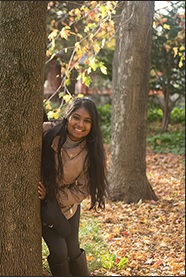Emblems of Canada: tree edition
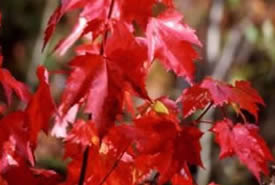
Red maple (Photo by Jean Isaacs)
Trees have played a significant cultural role in the lives of many Canadians; they are engrained in our national identity. Take the Canadian flag, for instance. It features a single, prominent red maple leaf in the centre, which speaks to the abundance of maple trees in Canada and which is Canada’s official arboreal emblem.
Fun fact: There are 10 different species of maple trees native to Canada, including sugar, black, silver, bigleaf, red, mountain, striped, Douglas, vine and Manitoba.
It is hard to consider Canada without trees, especially since forests are at the forefront of iconic landscapes here. Almost 35 per cent of our country is covered with trees. Canada has about 180 different tree species and eight distinct forest regions. Ecologically, trees are important because they provide habitat, food and shelter for many species, they purify our air and water, hold significant amounts of carbon and help control floods.
Today marks National Tree Day, a day to step back, appreciate and be reminded of the numerous benefits that trees provide. Honour trees today by not only helping plant some in your local community, but by learning about some of our country’s great tree species.
Did you know each province and territory in Canada has an official tree? Each represents and reflects the natural and diverse landscapes of the province or territory. Discover your provincial or territorial official tree below.
British Columbia
Western red cedar
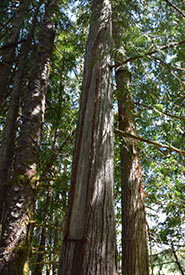
Culturally modified western red cedar (Photo by NCC)
IUCN (International Union for Conservation of Nature) Conservation status: least concern
Description: Western red cedars are large, tall coniferous trees that can reach heights of up to 60 metres and up to eight metres in circumference. The tree has yellow-green scale-like leaves, with drooping branches and reddish-brown bark. Mature trees have seed cones that ripen in late summer and shed in the winter.
Habitat: A western species, the tree grows best on sites with moist soil that is rich with nutrients. It is found in coastal and interior temperate rainforests of BC.
Interesting fact: Western red cedar is also known as arborvitae, meaning “tree of life,” because it held cultural significance for Indigenous Peoples on Canada’s West Coast. The tree provides shelter, clothing, transportation and medicine.
Alberta
Lodgepole pine
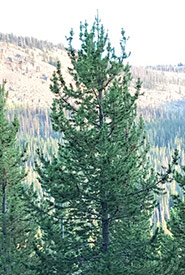
Lodgepole pine (Photo by Robb Hannawacker, iNaturalist, CC0 1.0)
IUCN conservation status: least concern
Description: A tall, slender conifer growing up to 30 metres in height, lodgepole pine has a straight trunk and dark to yellow-green needles. Needles grow in pairs and in dense clusters toward the end of branches, which curve upward. Lodgepole pine bark is thin, orange-brown to gray in colour and finely scaled.
Habitat: Although it can grow on a variety of sites, lodgepole pine grows best on well-drained loam (soil composed of clay and sand). It is found in the montane and subalpine forests of BC and Alberta.
Interesting fact: Healthy lodgepole pine forests have frequent surface fires that clear the undergrowth, but do not impact mature trees.
Saskatchewan
White birch
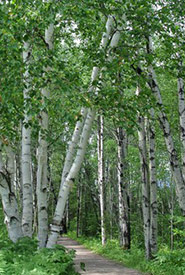
White birch (Photo by stevenland, iNaturalist, CC BY-SA 4.0)
IUCN conservation status: least concern
Description: Recognizable by their papery white bark, white birch trees are medium-sized deciduous trees reaching up to 25 metres in height. Their leaves are green and egg-shaped or triangular. The bark is thin and smooth, with dark horizontal slits.
Habitat: A widespread species across Canada, this tree can grow anywhere as long as it receives enough sunlight. White birch can be found growing on a variety of soils in open to dense woodland.
Interesting fact: White birch gets its nickname, “paper birch,” from the colour and texture of its bark. Its thin, white bark peels off in papery layers.
Manitoba
White spruce
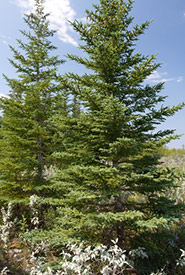
White spruce (Photo by Samuel Brinker, iNaturalist, CC BY-NC 4.0)
IUCN conservation status: least concern
Description: White spruce has short, bluish-green to green needles that are four-sided and have lines of white dots along the sides. Its grey-brown bark is smooth and thin when young, but becomes loose and scaly with age. This coniferous tree can reach up to 25 metres in height and has scaled light-brown seed cones hanging from its upper branches.
Habitat: One of the most common trees in Canada’s boreal forest, white spruce can grow under a range of climatic conditions and a variety of soil types. White spruce can grow on dry areas if they are fertile and tolerate sites with a range in moisture conditions.
Interesting fact: The tree is often cultivated for Christmas, as white spruce is known as the ”traditional Christmas tree.”
Ontario
Eastern white pine
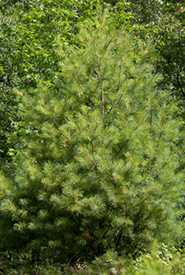
Eastern white pine (Photo by John D Reynolds, iNaturalist, CC BY-NC 4.0)
IUCN conservation status: least concern
Description: Eastern white pine has skinny, dark blue-green needles that are long, straight and grow in bundles of five. When young, bark on the species is grey-green and smooth. When eastern white pine is older, its bark is dark brown to black in colour and deeply creased. Eastern white pine can reach heights of 30 metres and occasionally taller.
Habitat: The trees grows best in full sunlight and on moist, sandy loam. Eastern white pine can grow in forests and open areas. It is common in the Great Lakes-St. Lawrence forest region of central Canada.
Interesting fact: Ontario’s largest eastern white pine tree was discovered along the Ottawa River in 2015. It measures 47 metres tall and is located on the Nature Conservancy of Canada’s Gillies Grove Nature Reserve.
Quebec
Yellow birch
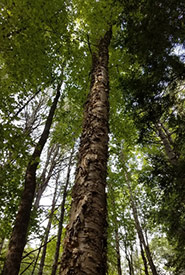
Yellow birch (Photo by Clare Smith, iNaturalist, CC BY-NC 4.0)
IUCN conservation status: least concern
Description: A medium-sized tree growing up to 25 metres tall, yellow birch has yellowish-green oval leaves and red-brown bark that is thin and shiny. With age, its bark becomes a dull yellow and darkens to a bronze colour at maturity. Unlike white birch, yellow birch bark does not peel off easily. Instead, it naturally flakes in skinny, horizontal strips.
Habitat: This species grows best in areas with plenty of precipitation and moist, rich soil. It is common in the Great Lakes-St Lawrence and Acadian forest regions of central Canada and the Maritimes.
Interesting fact: When rubbed or scratched, the twigs and leaves of yellow birch release a pleasant minty wintergreen scent.
New Brunswick
Balsam fir
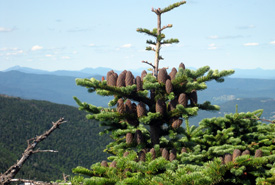
Balsam fir (Photo by Wikimedia Commons)
IUCN conservation status: least concern
Description: A wide-ranging and common species, balsam fir has flat needles that are shiny and dark green, with two white bands underneath and rounded tips. Growing up to 25 metres tall, the tree has smooth and waxy bark that ranges from grey to brown, depending on its age.
Habitat: The tree can grow in various climates and soils and is common in the Acadian and boreal forest regions.
Interesting fact: Balsam fir’s long wood fibres are great for producing high-quality paper. Sap from the tree is used in manufacturing soap, candles and glue.
Newfoundland and Labrador
Black spruce
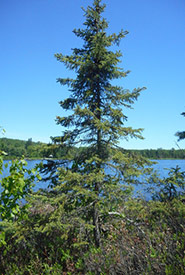
Black spruce (Photo by David Legros, iNaturalist, CC BY-NC 4.0)
IUCN conservation status: least concern
Description: Black spruce is a small to medium-sized conifer, which, under ideal conditions, can reach heights of up to 30 metres. Its needles are short, stiff and a dull blue-green, with white dots lining the lower surface. Black spruce pine cones are small and egg-shaped, and appear purple when young and turn brown with age.
Habitat: An adaptable species, black spruce grows well in a variety of soils and moisture conditions, but is most often found growing in cold, soggy areas, such as bogs and swamps. In wetlands, the tree grows to be much smaller than in areas on high and dry ground. It is one of the tree species that dominates Canada’s boreal forest region.
Interesting fact: Black spruce needles and twigs are use to make an essential oil for easing dry skin, improving overall skin health and for therapeutic respiratory purposes.
Nova Scotia
Red spruce
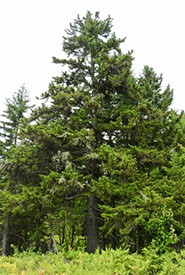
Red spruce (Photo by jlmason, iNaturalist, CC BY-NC 4.0)
IUCN conservation status: least concern
Description: This medium-sized conifer can grow to 25 metres tall. Its curved, blunt-pointed needles are yellow-green in colour and lined with faint white dots on all sides. Red spruce bark is grey when the tree is young and becomes reddish-brown as it matures. Its cones are chestnut brown.
Habitat: Red spruce prefers well-drained soils and can be found in forests on moist upland sites. The species is shade tolerant. It is mainly restricted to the Acadian forests of the Maritimes.
Interesting fact: Red spruce wood is best used in making stringed instruments, such as guitars, violins and mandolins.
Prince Edward Island
Northern red oak
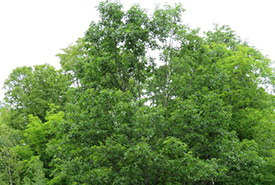
Northern red oak (Photo by Owen Clarkin, iNaturalist, CC BY-NC 4.0)
IUCN conservation status: least concern
Description: Growing to 25 metres tall, northern red oak is a medium-sized deciduous tree with long yellow-green leaves. Its bark is dark grey and smooth when young, becoming pale grey with ridges when older. In fall, its leaves turn bright red to reddish-brown. Northern red oaks produce acorns that are round and red-brown, with twigs of the same colour that have thin scales along the top.
Habitat: Northern red oak is fast-growing under optimal conditions and full sunlight. The tree grows in a variety of soils and moisture levels but needs room to grow. The species becomes shade-intolerant as it ages. It is found in the Acadian, Great Lakes-St. Lawrence and Carolinian forest regions.
Interesting fact: If a northern red oak tree falls over or is cut down, the tree may not be dead, as the species sprouts easily from its trunk. New sprouts may regenerate from the stump.
Yukon
Subalpine fir
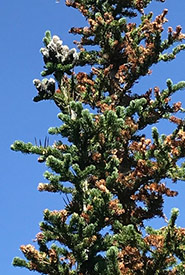
Subalpine fir (Photo by Robb Hannawacker, iNaturalist, CC0 1.0)
IUCN conservation status: least concern
Description: This medium-sized conifer grows up to 30 metres tall, with short, drooping branches that allow it to withstand heavy snow loads. Needles range from grey-green to a light blue-green, with lines of white dots on the lower surface. Cones are grey-brown to deep purple, and its bark is smooth grey, becoming grey-brown and scaly with age.
Habitat: Subalpine fir often can be found growing well at higher elevations and on a variety of soils. It grows in the mountains of the Yukon Territory and extends south into the subalpine forests of Alberta and BC.
Interesting fact: Sap from the bark of subalpine fir has been used as a traditional medicine for lung ailments by the Indigenous Peoples.
Northwest Territories
Tamarack
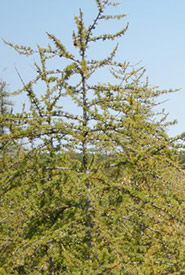
Tamarack (Photo by aezammit, iNaturalist, CC BY-NC 4.0)
IUCN conservation status: least concern
Description: A deciduous conifer, meaning they loses their needles every fall, tamaracks are small- to medium-sized trees, reaching heights of 25 metres. Their slender trunk is covered with thin bark, which at first is grey and smooth, becoming red-brown and scaly with age. Their needles are blue-green, turning a yellow-green before they shed.
Habitat: This species can be found in bogs and swamps. It is intolerant of shade and requires full sunlight to thrive. A widespread species in Canada’s boreal forest region, tamarack can grow in various soils with varying moisture levels.
Interesting fact: Tamarack wood is commonly used to create fence posts and telephone poles as it is durable and decay resistant.
Nunavut
Nunavut does not have an official arboreal emblem.
Get outside and witness the majestic grandeur of these tree species by visiting the Nature Conservancy of Canada’s Nature Destinations, which features some of Canada’s greatest natural areas.
The Conservation Internship Program is funded in part by the Government of Canada’s Summer Work Experience program.


